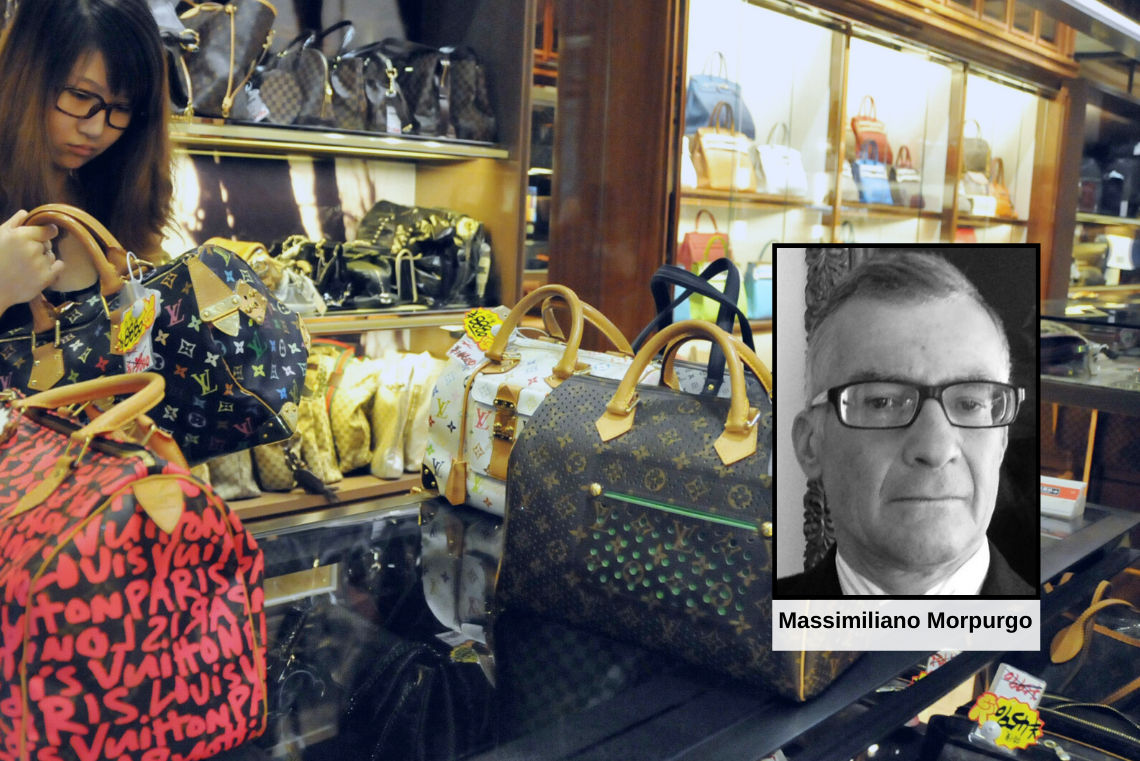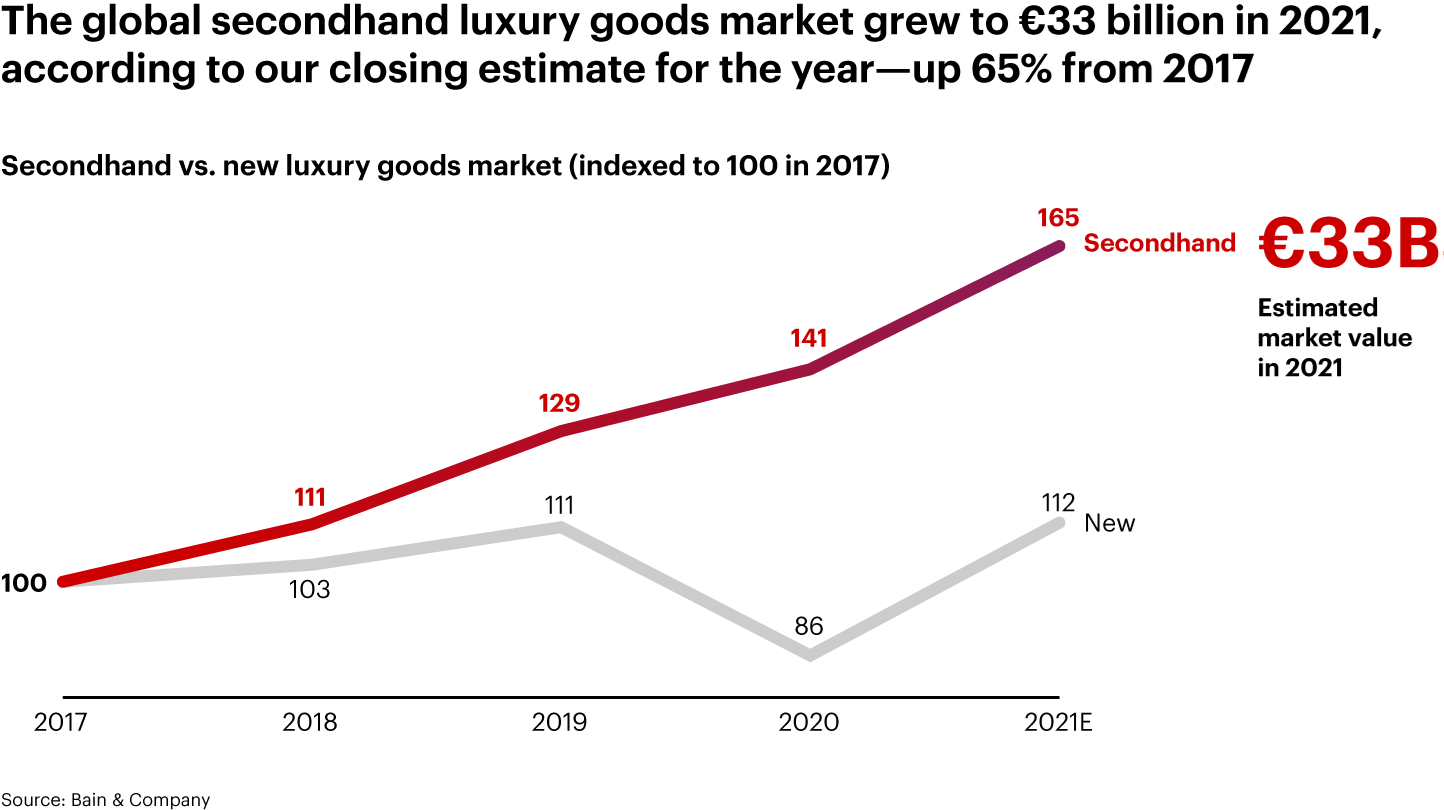Secondhand Opportunity in Luxury Goods Market

The global secondhand luxury goods market grew to €33 billion in 2021, according to Bain closing estimate for the year, up to 27% from 2017. Extending the lifetime of luxury products is a powerful way for brands, fashion platforms, and investors to show their commitment to sustainability. Moreover, secondhand sales offer an additional distribution channel that’s gaining share within the larger luxury ecosystem. The network-based nature of secondhand luxury retail (and its capacity to give brands a richer, data-led understanding of young consumers’ behavior) is another plus. However, the real market opportunity is represented by secondhand hard luxury items—primarily watches and jewelry—. Those product categories are worth about €21 billion worldwide and growing at 8% a year, faster than the luxury industry overall, this market is still in the early stages, creating an opportunity for brands and retailers.

According to a BCG survey in the hard luxury category, watches account for about 75% of secondhand sales, with jewelry making up the remaining 25%. Offline sales still dominate—though the online channel will expand its share as a result of consolidation and the market entry of classic players—and Europe is the largest region. In the survey conducted 62% of luxury consumers said they would consider buying a secondhand luxury item and 25% indicated that they made such a purchase in the past year (18% of whom purchased watches and jewelry).
Key insights for secondhand hard luxury.
Secondhand luxury sales are expanding mainly because of the increase in online sales, changing consumer preferences, and rising concern about the sustainability of luxury goods, particularly among younger consumers.
Prices are more attractive for secondhand products (with no immediate drop in value as occurs following the purchase of new items).
Another factor in the growth of secondhand hard luxury is social media and digitization, which are becoming far more influential in driving purchases, giving consumers easier access to personalized premium services. These new channels make heritage storytelling more relevant in shaping a brand’s identity. And brands and retailers increasingly rely on social media to promote luxury experiences and events as well as geographically specific product offerings.
The biggest growth driver is the rise in consumer demand for secondhand hard luxury goods. Consumers of secondhand hard luxury items skew slightly in favor of men (55%) and tend to be younger (mostly millennials and Gen Z). The increased activity of younger generations reflects their pronounced preference for an experience with a brand: they would rather the relationship be more like a service than traditional ownership. These consumers are also more interested in hunting for bargains and making deals. They factor sustainability into their purchasing decisions to a greater degree than previous generations and pay increasing attention to resale value, treating hard luxury goods as investments. Consumers expect luxury brands and retailers to get involved in secondhand sales and they would like brands to certify secondhand products that are sold through resellers.
THE THREE PRODUCT SEGMENTS OF SECONDHAND HARD LUXURY
Unworn and Preowned Pieces. Luxury products that have never been worn (typically from last season) are highly desirable to budget-conscious consumers because of the items’ discounted prices. Similarly, preowned pieces are usually less than ten years old, making them valuable but still accessible to many buyers. Both unworn and preowned segments offer important opportunities for a brand to recruit new consumers—secondhand owners can be motivated to exchange their existing products, thus stimulating demand for new ones.
Vintage Pieces. These hard luxury products are valuable and generally 10 to 30 years old. They are in high demand due to their timeliness and quality and have a substantial impact on brand equity. Iconic Heritage Pieces. These historic, high-value products are at least 30 years old. They are the most desirable pieces because of their iconic history and have the largest impact on brand equity.
The three reseller components
The segmentation of the market creates an opportunity for retail, companies position themselves in the market according to two dimensions: their degree of specialization and the product segments – Iconic, vintage, preowned, unworn, – in which they compete.
We divide the reseller market into three components: generalists that focus on preowned or unworn products, luxury generalists that focus on preworn pieces as an additional service for its customers, hard luxury specialists offering secondhand iconic and heritage products alongside new pieces in their high-end jewelry business aiming at reinforcing the company’s rich history.
Online marketplaces (such as eBay) and resale companies (Jomashop, for instance) have strong operations and e-commerce capabilities, along with high volume and a large inventory. In addition, a number of online players—like Watchbox, Watchfinder, and Chrono24, among others—have successfully focused in recent years on higher priced pre-owned products.
.png)
Unfortunately, classic luxury brands and retailers that offer an established experience but may not be as strong in terms of operations and e-commerce; some may be entirely offline. Classic players should invest in this segment through the right mix of capabilities: operational excellence, reach, and e-commerce. Iconic, heritage brand could create a bespoke sales channel developed and executed internally—including an online platform, in-store sales and dedicated events, as well as private auctions— with the capabilities needed to certify products as authentic and price them accordingly.
By combining these elements, brands and retailers could cultivate new customers, preserve their brand’s heritage, better meet the changing needs of consumers in areas such as sustainability, and build their brand equity overall.
Tailored Approach
Some luxury players are more concerned with goals related to their brand’s image, such as protecting their brand equity or establishing themselves as a sustainability leader. Other strategic aims are more financial in nature, such as recruiting new customers, developing a new sales channel, or centralizing secondhand business services as a profit pool.
Acquisition. Luxury brands and retailers could acquire a platform or retailer and fold it into their organization.
Acquisitions have the advantage of speed and centralization. A company can quickly gain access to critical capabilities for the secondhand market while still retaining full control. As with any acquisition, however, the integration element can be challenging, and success requires that the two businesses address these issues head-on.
Partnership. Another option is to partner with an existing player—for example, a department store teaming up with an online platform. Partnerships are recommended for players that want to quickly complement their capabilities and expand into the secondhand market with a limited investment.
Joint Venture. Companies could coinvest with an existing player, such as an online platform or retailer, in a new joint venture that specializes in secondhand hard luxury. These arrangements are a good option for players that want to control their brand equity and complement their own capabilities with those of another company.
Newly Created Offering. Luxury brands and retailers could create a novel offering that features secondhand pieces (typically branded as “certified preowned”) along with the portfolio of new products. The offering could be part of the existing brand or a new one, with operations run either internally or externally. This approach is recommended for players that want to preserve their brand heritage and invest in a more sustainable offering and image.
CONCLUSION
Consumers are increasingly interested in secondhand hard luxury goods and have greater access to them than ever before, this creates a significant opportunity for brands and retailers to add complementary sales, recruit new customers, and support sustainability agendas. Brands could face some operational challenges in capitalizing on the opportunity, but the market for secondhand hard luxury goods is large, growing, and dynamic—and it is here to stay in the new luxury reality.
If you would like more information or to be contacted by CDI Global regarding your next deal, please click here.
By: Massimiliano Morpurgo
massimiliano.morpurgo@cdiglobal.com

















































